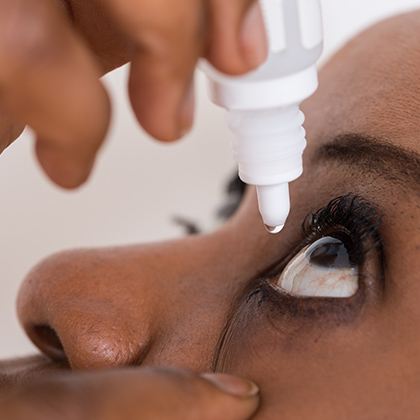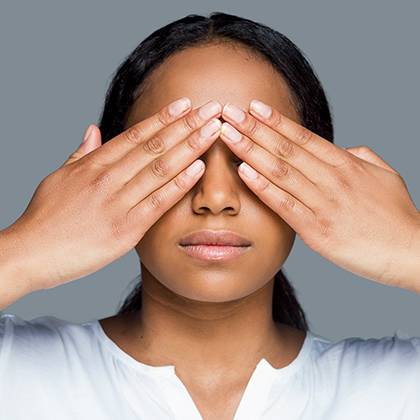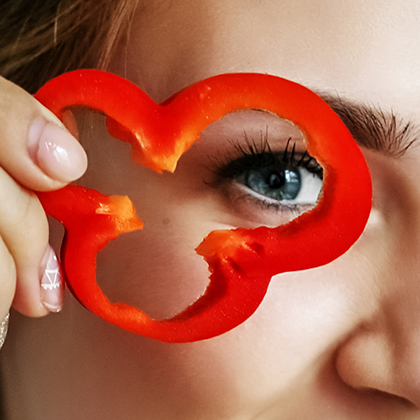
If you’ve ever woken up with a pair of bloodshot eyes, you’re far from alone. Eye redness is so common that most people will have experienced it at some point or other. They’re caused when the blood vessels supplying the conjunctiva – the thin transparent membrane that covers the front surface of your eye – become dilated or inflamed. Sometimes you may just have a few pink or red lines crossing the whites of your eyes, or sometimes the entire white parts of your eyes may change colour. However, while bloodshot eyes can look serious, most cases are harmless and don’t usually last longer than a day or two. To help you reduce the symptoms red-eye quickly and naturally, we’ve put together this guide.
What causes red-eye?
Lifestyle factors
A number of lifestyle factors can contribute to the development of red-eye, the most common being a lack of sleep and excessive smoking and drinking. Even something as simple as contact lenses — which are intended to improve your vision — could actually be contributing to eye redness. Thicker contact lenses can reduce oxygen flow to the eyes, causing them to become red. So, if you’re a lens wearer, you might consider asking your optician to switch to an alternative lens. What’s more, if you use eye whitening drops to help reduce redness, they could actually be making the problem worse. Whitening drops work by shrinking the enlarged blood vessels, but if you overuse them they can become less and less effective, causing your blood vessels to become larger than they were before. So if you do use whitening drops, use them as directed for a short time. Several environmental factors can also cause red-eye, including; air pollution, smoke, dust, dry air, and unprotected sun exposure.
Related conditions
Alongside lifestyle factors, red-eye can be a secondary symptom of other common conditions, one of which being allergies. Hay fever and allergic reactions to pet dander, dust or mould can causes eyes to become red, itchy and uncomfortable, and you may also experience other symptoms such as sneezing, and a runny or stuffy nose. Additionally, if you experience dry eye syndrome, your eyes can also become red and irritated because they don’t make enough tear fluid to stay lubricated. Common eye infections such as conjunctivitis, uveitis and blepharitis are another cause of red-eye. Blepharitis can be caused by a bacterial infection called staphylococcus or a skin condition called seborrheic dermatitis, or it may happen when glands on the inside rim of your eyelids (meibomiam glands) become irritated and inflamed. For more on this, see our guide to the signs, symptoms and treatments of common eye infections.
 Eye conditions such as glaucoma can cause eye redness as well as other symptoms including intense eye pain, headache, nausea and vomiting, and cloudy vision. Additionally, if you have an ulcer on your cornea – the outer layer at the front of the eyeball – red-eye may be a related symptom. Most simply, however, bloodshot eyes can be caused by just bursting a blood vessel in your eye. As frightening as this may sound, it’s not often serious and should clear within a few weeks.
Eye conditions such as glaucoma can cause eye redness as well as other symptoms including intense eye pain, headache, nausea and vomiting, and cloudy vision. Additionally, if you have an ulcer on your cornea – the outer layer at the front of the eyeball – red-eye may be a related symptom. Most simply, however, bloodshot eyes can be caused by just bursting a blood vessel in your eye. As frightening as this may sound, it’s not often serious and should clear within a few weeks.
If you’re worried you may have any of these conditions, it’s best to book an appointment with your GP or an optician.
How to reduce red-eye symptoms
The treatment for red eyes largely depends on the cause. To help, we’ve outlined a few steps to reduce symptoms quickly and naturally.
Keep your eyes lubricated
If the problem is caused by lifestyle or environmental factors, using over-the-counter drops may help if your eyes feel uncomfortable, dry or itchy. Additionally, you could try applying a cool or warm compress (or alternating between the two) a few times a day. Meanwhile, it’s always best to ensure that you’re drinking enough fluids to keep your eyes hydrated from the inside.
Remove irritants
If you know that certain things tend to make your eyes red, it’s a good idea to avoiding those triggers whenever possible. For example, If you’re a contact lens wearer, switching to a different type of lens may also be helpful since the materials certain lenses are made from can make your eyes more susceptible to infection or irritation. If your eyes are sensitive to eye makeup, try using hypoallergenic products instead of your usual brand. Getting more sleep may also solve the problem if you’ve been burning the candle at both ends.
Consider a natural supplement
If you’ve tried a number of methods, it might be worth considering a natural supplement. Nutrients such as sea buckthorn oil and fish oils have been found to help improve dry eye symptoms such as redness.I, ii For more on this, see our guide on how to prevent dry eyes. There’s also some evidence that fish oils may help with the symptoms of blepharitis.iii Learn more the eye health benefits of Omega 3 in our article. Antioxidant substances called anthocyanidins may help to support the blood vessels in the eyes, as they are known to maintain small blood vessel health. These compounds are found in dark red-blue plant pigments, including blueberries, blackberries, blackcurrants, black and red grapes, raspberries and aubergines, but can also be found in a high-quality supplement.
If your symptoms of red-eye persist, it’s best to book an appointment with your GP. For even more articles and advice on a range of common eye conditions, feel free to visit our Vision Health Hub.
References:
-
Larmo, P.S., Jarvinen, R.L., et al. Oral sea buckthorn oil attenuates tear film osmolarity and symptoms in individuals with dry eye. J Nutr. (2010 Aug) ;140(8):1462-8. Available online: https://www.ncbi.nlm.nih.gov/pubmed/20554904
-
Rahul, B., Prachi, K., et al. A randomized controlled trial of omega-3 fatty acids in dry eye syndrome. Int J Opthalmol. (2013) ;6(6):811-816. Available online: https://www.ncbi.nlm.nih.gov/pubmed/24392330
-
Macsai, M.S. The Role of Omega-3 Dietary Supplementation in Blepharitis and Meibomian Gland Dysfunction. Trans Am Opthalmol Soc. (2008);106:336-356. Available online: https://www.ncbi.nlm.nih.gov/pubmed/19277245
Related Posts?
Disclaimer: The information presented by Nature's Best is for informational purposes only. It is based on scientific studies (human, animal, or in vitro), clinical experience, or traditional usage as cited in each article. The results reported may not necessarily occur in all individuals. Self-treatment is not recommended for life-threatening conditions that require medical treatment under a doctor's care. For many of the conditions discussed, treatment with prescription or over the counter medication is also available. Consult your doctor, practitioner, and/or pharmacist for any health problem and before using any supplements or before making any changes in prescribed medications.

Christine
Christine Morgan has been a freelance health and wellbeing journalist for almost 20 years, having written for numerous publications including the Daily Mirror, S Magazine, Top Sante, Healthy, Woman & Home, Zest, Allergy, Healthy Times and Pregnancy & Birth; she has also edited several titles such as Women’ Health, Shine’s Real Health & Beauty and All About Health.
View More



